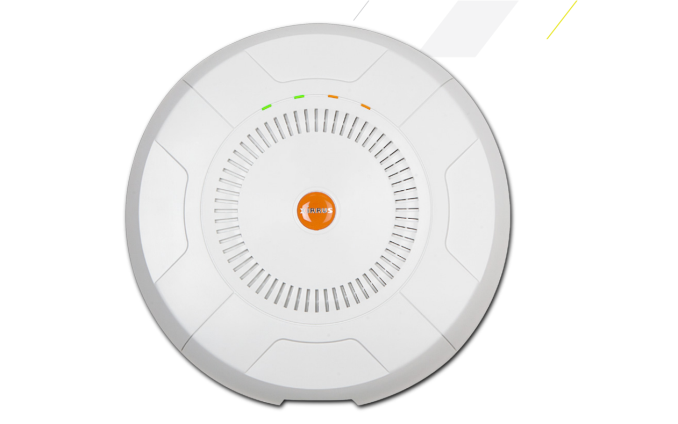Xirrus to Offer Low Cost 2x2 802.11ac Upgradable Enterprise AP
by Ian Cutress on March 11, 2014 8:00 AM EST- Posted in
- WiFi
- Enterprise
- 802.11ac
- Xirrus

A good number of companies play in the enterprise Wi-Fi market: Aruba Networks, Ubiquiti and Ruckus Wireless to name a few. Enterprise Wi-Fi looks at markets that have dense casual user access but high levels of management therein, such as hotels, dormitories, hospitals, waiting rooms, office spaces and retail areas. Last year Ganesh reported on Ubiquiti’s initial Enterprise Wi-Fi AP offering, and a year further down the line Xirrus got in contact regarding their 802.11ac AP line. Xirrus’ offering comes from the point of view of upgradeability – buy an 802.11ac access point at 802.11n prices, but further down the line pay for a software update to enable 802.11ac access. This method of delivering data would allow businesses to upgrade without the need to replace hardware as well as spread the cost of network upgrading.
The main product Xirrus got in contact with us about is the new XR-620 Access Point, designed to be the lowest-cost 2x2 802.11ac enterprise solution on the market. This system is based off a Qualcomm Atheros SoC, and due to the dual stream nature the device is capable of 867 Mbps per radio. This is compared to Xirrus’ 3x3 XR-630 that can manage 1.3 Gbps per radio. The AP will have dual radios for 2.4 GHz/5GHz or dual 5 GHz operation, and be suitable for up to 240 concurrent users with four integrated antennas. While there are two gigabit Ethernet points (802.3ad / link aggregation compatible), cloud based management comes part of the solution as well. The XR-600 series comes with intruder detection and prevention systems with zero touch provisioning.
Administrators controlling the AP will have access to Xirrus’ Application Control. This software uses Layer 7 deep packet inspection to prioritize access of certain applications over others, with 1200+ applications being monitored. While not explicitly mentioned, Xirrus does have dedicating meshing support on the 620.
Xirrus are bringing the XR-620 into the market at $675, with availability in March.
Source: Xirrus











21 Comments
View All Comments
Daniel Egger - Tuesday, March 11, 2014 - link
Actually I now see what you mean, the 2.4GHz can be switched to 5GHz operation. However I'm not quite sure why someone would sacrifice 2.4GHz operation for small advantage 2x5GHz operation in the same would give; usually it's all about coverage not maximum number of power users in a small spot. And then again you could get almost twice the amount of devices from Ubiquity plus they're 3x3 instead of 2x2.Patrian - Tuesday, March 11, 2014 - link
Users per radio and connections ate marketing baloney. Connect 200 users per radio and factor true throughput and you will see what I mean.Now, would you buy a 24 port switch with half 1Gb and half 100Mb? No... why do the same for wireless? In most cases a 2.4 radio will never do more than 150mb throughput because you do not bond in 2.4 On the other hand, trading that for an additional ac radio gives you an additional 400-550mb actual throughput... this is a huge gain.
L0cus - Wednesday, March 12, 2014 - link
That's blinders-on logic. Any network engineer has had to design networks for oversubscription since they first existed. Using your analysis would imply that it would be ridiculous to assume any 24 port gig switch should also have a 24gig uplink port, of which none of them do.The true marketing spin is that getting rid of 2.4 to boost marketing throughput numbers implies that someone only owns all 5Ghz 3x3 devices, and doesn't want to use their Kindles, or Xbox, or PS, or any devices built prior to 6 months ago.
Patrian - Wednesday, March 12, 2014 - link
You miss the scale of things. Why run GigE at all if you are willing to give 20-50 people in a room what amounts to no more than 200-600Mb/s throughput? At least your 24port switch can have multiple 1Gig or even a 10Gig uplink and has a multi Gig back. At the end of the day, your 2.4Ghz radio is no better than 75Mb/s in most cases and no more than 150Mb/s in the best of cases when your 5Ghz can do 150-250Mb/s in 802.11n and 450-700Mb/s in 802.11ac.Also, again Xirrus APs are not made for home but primarily for high dense areas. Even still, would you want to run on a 75Mb/s connection or a 500Mb/s connection?
phoenix_rizzen - Monday, March 17, 2014 - link
This is doable if and *only if* all your devices support 802.11ac. It will still be several years before we can turn off 802.11g let alone 802.11n. Meaning, 2.4 GHz will be around for many many many more years.Also, 5 GHz doesn't have the range and penetration that 2.4 GHz does, making it less than useful in some areas.
Patrian - Tuesday, March 11, 2014 - link
No... not confusing. Xirrus radios are software selectable and can support any number of configurations one being both radios operating in 5Ghz 802.11ac.ThugEsquire - Friday, May 22, 2015 - link
Unlike every other vendor out there, Xirrus radios are software-programmable, so you can switch both to 5 GHz (and 11ac) on-the-fly. Really makes the long-term prospects much better than other companies in the space.Communism - Tuesday, March 11, 2014 - link
For home users laptop with 2 gigabit ethernet ports + multiple antennas makes the perfect router/firewall/server/nas combo. Just add a switch and you're set.anything from a core 2 duo on up should be fast enough to do all those duties at once for a home connection.
Conficio - Wednesday, March 12, 2014 - link
LOL - I have dozens of laptops lying around with two gigabit ethernet portsZerointerrupt - Friday, March 21, 2014 - link
And now we have our first Meraki clone...